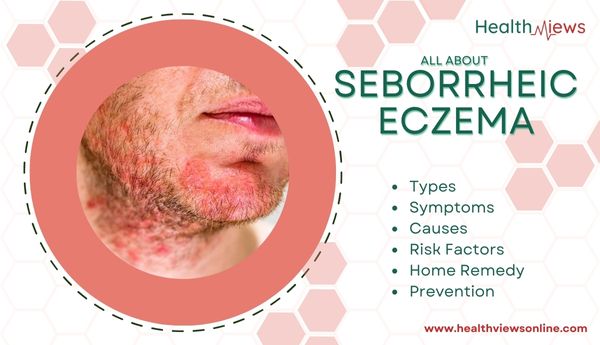What is Seborrheic Eczema?
Seborrheic dermatitis, a chronic form of eczema, is a skin disorder that primarily affects the scalp. It results in scaly patches, irritated skin, and persistent dandruff.
It develops on the body where there are a lot of oil-producing (sebaceous) glands, such as the upper back, nose, cheeks, sides of the nose, brows, ears, eyelids, chest, and scalp.
Seborrheic dermatitis is a recurrent disorder that develops, goes away with treatment, and recurs occasionally.
Types
Seborrheic dermatitis has two types:
- Infantile seborrheic dermatitis: This illness results in a red rash that spreads to the infant’s crotch and armpits. The salmon-pink scaly areas have the propensity to rip off. Source
- Adult Seborrheic dermatitis: This type of dermatitis most frequently affects the scalp and folds of skin that are subject to sweat and oil production.
Causes
The cause of seborrheic dermatitis is unknown. It could be caused by the yeast Malassezia, excess oil in the skin, or an immune system imbalance.
Also Read: All About Ringworm: Types, Symptoms, Causes, Risk Factors, Home Remedy, Prevention
Risk factors
The following factors are thought to raise risk:
- Obesity
- Pollution and other environmental factors
- Inadequate skin care.
- The occurrence of other skin problems, such as acne
- Usage of certain skin care products, especially those containing alcohol
- Some medical diseases, such as Parkinson’s disease or HIV
- Detergents, soaps, and chemicals that are harsh
- Cold and dry weather drugs such as psoralen, interferon, and lithium
- Hormonal alterations.
Symptoms
You should be aware of the following seborrheic dermatitis symptoms and indications that are frequently seen:
- Scalp with scaly patches
- Dandruff on the eyebrows, eyelashes, and scalp
- On the scalp, face, eyelids, eyebrows, chest, armpits, groin, etc., there are whitish-yellow flaky scales covering diffuse regions of oily or greasy skin.
- Itching
- Specific regions of the skin exhibit redness and irritation
Diagnosis
Your doctor will ask you questions about your medical history and examine your skin. They may scrape a piece of skin and examine it under a microscope to rule out skin disorders such as psoriasis, eczema, Rosacea, allergic response, and systemic lupus erythematosus (SLE).
Treatment
Seborrheic dermatitis is a chronic skin condition that calls for constant care. However, you can effectively manage the issue by:
- Shampoos, ointments, and creams for external use – These contain corticosteroids like hydrocortisone, clobetasol, desonide, and others, and many of them are prescription medications. These must be taken in accordance with your doctor’s prescription and at the suggested dosage.
- Antifungal drugs- Your doctor might on occasion recommend an antifungal drug. Source
- Metronidazole – Another medication that reduces symptoms by eliminating germs is metronidazole. Both cream and gel versions are available.
- Psoralen and light treatment can be combined by your doctor to help manage the symptoms of seborrheic dermatitis.
- Treating cradle cap – Care for cradle cap. Most of the time, the cradle cap doesn’t need medical attention. Usually, it becomes better within six months. Source
- Other medications consist of:
- Ketoconazole
- Sodium sulfacetamide Ciclopirox
- Tacrolimus or pimecrolimus, two corticosteroids (medicines that suppress the immune system)
Home remedies
Skin type and sensitivity are factors in Seborrheic Eczema triggers. When it comes to natural cures, there is no one-size-fits-all solution. Here are some home methods for treating flare-ups or preventing their symptoms:
- Fish oil Source
- Aloe Vera
- Probiotics
- Tea tree oil
- Apple cider vinegar
- Olive oil
- Eat a diet that includes:
- plenty of green, leafy vegetables
- tomatoes
- Antioxidant-rich fruits such as cherries, strawberries, and blueberries
- Vitamin C-rich foods, such as citrus and bell peppers, etc
- Almonds
- Sweet potatoes
- Vitamin E-rich foods, such as wheat germ and avocados
- Good skin care Source
Also Read: Health Benefits of Avocado Fruit: Nutrient Value, Health Facts & Advantage
Prevention
Like other skin disorders, seborrheic dermatitis has no known cause. However, avoiding any aggravating conditions is the best method to stop a flare-up of the condition:
- Reduce stress
- Avoid any known allergies
- Stay away from woolen and wear only cozy, breathable cotton clothing.
- Get multivitamins.
Want to know about other skin disorders? Check out Skin Problems on Health Views Online.





